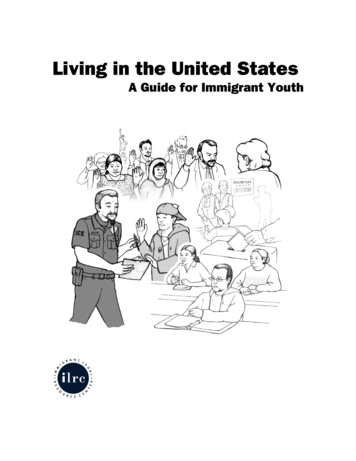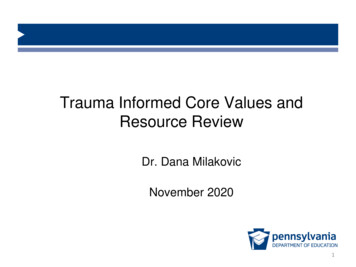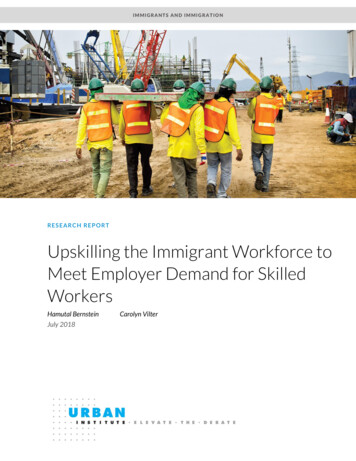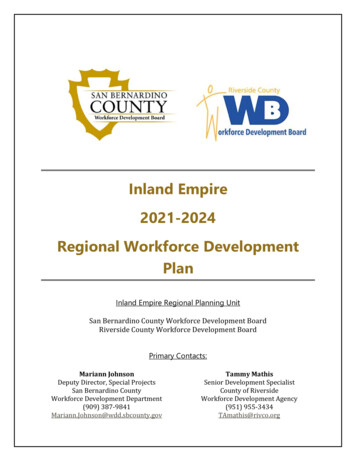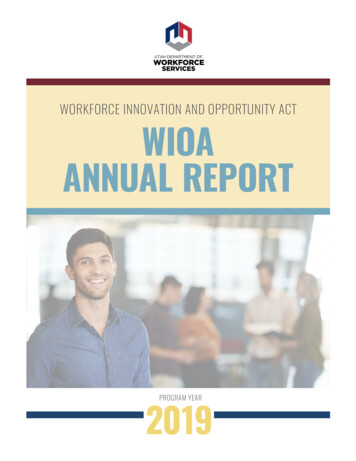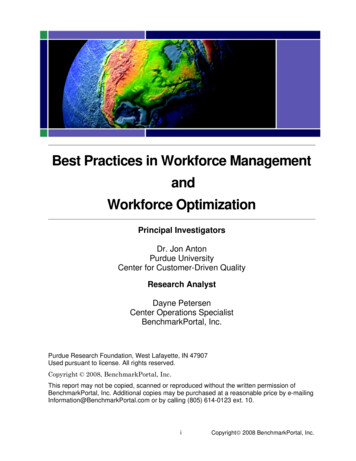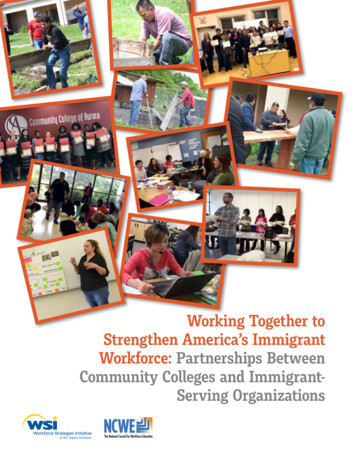
Transcription
Working Together toStrengthen America’s ImmigrantWorkforce: Partnerships BetweenCommunity Colleges and ImmigrantServing Organizations
2016 by WSI at the Aspen InstitutePublished in the United States of America 2016 by the Aspen InstituteAll rights reservedbWorking Together to Strengthen America’s Immigrant Workforce: Partnerships between Community Colleges and Immigrant-Serving Organizations
Working Together toStrengthen America’s ImmigrantWorkforce: Partnerships BetweenCommunity Colleges and ImmigrantServing OrganizationsMarcela Montes and Vickie ChoitzOctober 2016
AcknowledgementsThe Aspen Workforce Strategies Initiative would like to thank the individuals and organizationsthat made this paper possible. First of all, we thank the Annie E. Casey Foundation for itsgenerous support. We are especially grateful to Rosa Maria Castaneda and Laura Burgherfor their guidance and thoughtful feedback throughout the development of the paper. Weacknowledge that the findings and conclusions presented in this report are those of the author(s)alone and do not necessarily reflect the opinions of the Foundation.We also are grateful to all the organizations in the Building Community Partnerships to ServeImmigrant Workers initiative that participated in the interviews that informed our findingsand shared their perspectives and ideas on how to build, manage, and sustain partnerships toconnect immigrant workers to skill building and career advancement services. In particular, wewant to thank the partnerships who shared the program photos that we use in the cover of thispublication: Sonoma County, California Partnership; Aurora, Colorado Partnership; San MateoCounty, California Partnership; and the Westchester, New York Partnership.We also appreciate the assistance of our colleagues Darlene G. Miller and Nan Poppe of theNational Council for Workforce Education who provided insightful feedback as we developedand finalized the paper.Additionally, we would like to acknowledge our Aspen Institute colleagues Amy Blair andMaureen Conway and our former research intern Kelsey Kreider, all of whom provided supportand feedback throughout the process. Finally, we would like to thank Colleen Cunningham,Claire Daviss, Tony Mastria and Marc Miller for their efforts in preparing this paper forpublication.2Working Together to Strengthen America’s Immigrant Workforce: Partnerships between Community Colleges and Immigrant-Serving Organizations
Table of ContentsIntroduction . . . . . . . . . . . . . . . . . . . . . . . . . . . . . . . . . . . . . . . . . . . . . . . . . . . . . . . . . . 4Methodology . . . . . . . . . . . . . . . . . . . . . . . . . . . . . . . . . . . . . . . . . . . . . . . . . . . . . . . . . 7Why Partner? What Is the Value of Partnership? . . . . . . . . . . . . . . . . . . . . . . . . . . . . . . . . . . . 7What Is the Value to Community Colleges in Partneringwith Immigrant-Serving Organizations? . . . . . . . . . . . . . . . . . . . . . . . . . . . . . . . . . . . . . . . . 8What Is the Value to Immigrant-Serving Organizations in Partneringwith Community Colleges? . . . . . . . . . . . . . . . . . . . . . . . . . . . . . . . . . . . . . . . . . . . . . . . 9What Does It Take to Build, Manage, and Maintain Strong PartnershipsBetween Immigrant-serving Organizations and Community Colleges? . . . . . . . . . . . . . . . . . . . . .11Funding the Early Development of Partnerships . . . . . . . . . . . . . . . . . . . . . . . . . . . . . . . . . . .16Areas for Further Consideration and Research . . . . . . . . . . . . . . . . . . . . . . . . . . . . . . . . . . . . .20Conclusion . . . . . . . . . . . . . . . . . . . . . . . . . . . . . . . . . . . . . . . . . . . . . . . . . . . . . . . . . . 22Appendix: Snapshots of BCPIW Partnerships . . . . . . . . . . . . . . . . . . . . . . . . . . . . . . . . . . . . .23Pasadena Community Job Center and Pasadena City College . . . . . . . . . . . . . . . . . . . . . . . . . . .23International Institute of Minnesota and Saint Paul College . . . . . . . . . . . . . . . . . . . . . . . . . . . .24Centro Laboral de Graton and Santa Rosa Junior College . . . . . . . . . . . . . . . . . . . . . . . . . . . . . 25Neighbors Link Northern Westchester and Westchester Community College . . . . . . . . . . . . . . . . . .26Community Campus Partnership, The Learning Source,Community College of Aurora, and the Aurora Welcome Center . . . . . . . . . . . . . . . . . . . . . . . . . 27Jewish Vocational Service and Skyline College . . . . . . . . . . . . . . . . . . . . . . . . . . . . . . . . . . . 28Bluegrass Community and Technical College and Kentucky Dream Coalition . . . . . . . . . . . . . . . . . .29Working Together to Strengthen America’s Immigrant Workforce: Partnerships between Community Colleges and Immigrant-Serving Organizations3
IntroductionImmigrants are a sizable and growing segment of our nation’s workforce.1 The 26.3 millionforeign-born persons in the US labor force comprised 16.7 percent of the total labor force in2015, and some have projected an increase of 9.9 million by 2030.2 Yet many immigrants lack theeducation and English language skills needed to succeed in today’s economy. About 30 percentlack a high school diploma or equivalent, and about half of the country’s immigrant population isconsidered Limited English Proficient (LEP).3Given these numbers, it would seem that improving immigrants’ access to education, skillbuilding opportunities, and employment options would be a national priority. However,this is not the case, according to recent research by the Aspen Institute Workforce StrategiesInitiative (AspenWSI) and others. As described in our recent report, “Improving ImmigrantAccess to Workforce Services: Partnerships, Practices, and Policies,” immigrant and workforceorganizations are challenged to effectively meet the needs of new Americans and individuals withLimited English Proficiency.4 The reasons range from a lack of funding to confusing policies tolimited support for coordination among the organizations that serve or could serve immigrants.The National Skills Coalition recently described similar challenges.5One approach to helping expand immigrants’ access to skill-building and career-advancementopportunities is the formation of partnerships between workforce organizations and immigrantserving organizations. Workforce organizations — such as job centers, community colleges, andcommunity-based organizations (CBOs) providing employment services, education, and training— know how to help people build skills and access jobs. Immigrant-serving organizations— such as worker centers and immigrant-focused CBOs — know, deeply understand, and aretrusted by immigrant workers. After our research revealed that few such partnerships exist, wedelved deeper into why that is and identified several challenges, including: Limited understanding among immigrant-serving and workforce organizations of the valueof such partnerships; Lack of time and resources to develop and maintain partnerships; Lack of leadership and commitment to partnering with new and unfamiliartypes of partners;1We use the terms “immigrant,” “foreign-born,” and “new American” interchangeably to indicate a person born outside the United States. The termsencompass those who are legally authorized to work in the US (“work-authorized” or “documented”) and those who are not (“undocumented”). Insome cases, we refer to “unauthorized” or “undocumented” immigrants — those who lack legal authorization to work in the US. They make up aboutone-quarter of all immigrants in the US. (Jie Zong and Jeanne Batalova, “Naturalization Trends in the United States,” Migration Policy Institute, lastmodified August 10, 2016,).2For the number of foreign-born workers in 2015, see: “Foreign-born Workers: Labor Force Characteristics-2015,” Bureau of Labor Statistics,US Department of Labor, USDL-16-0989, released May 19, 2016. Accessed October 17, 2016. For projections of foreign-born workers, see:Dowell Myers, Stephen Levy, and John Pitkin, The Contributions of Immigrants and Their Children to the American Workforce and Jobs of theFuture, (Washington, DC: Center for American Progress, 2013), accessed August 17, 2016,. The percentage inthe workforce is slightly higher than that in the overall population. In 2015, the nation’s 41.3 million immigrants comprised 13 percent of the U.S.population. See Anna Brown and Renee Stepler, “Statistical Portrait of the Foreign Born Population in the United States,” Pew Research Center, lastmodified April 19, 2016, accessed August 17, 2016,.3The US Census Bureau uses the term Limited English Proficient (LEP) to classify people who report speaking English “less than very well.” SeeJie Zong and Jeanne Batalova, “The Limited English Proficient Population in the United States” Migration Policy Institute, last modified July 8 2015,accessed August 17, 2016,.4Marcela Montes and Vickie Choitz, Improving Immigrant Access to Workforce Services: Partnerships, Practices, and Policies, (Washington, DC:Aspen Institute, 2016), accessed August 29, 2016,.5Amanda Bergson-Shilcock, Upskilling the New American Workforce: Demand-Driven Programs that Foster Immigrant Workers Success & Policiesthat Can Take Them to Scale, (Washington, DC: National Skills Coalition, 2016), accessed August 17, 2016,.4Working Together to Strengthen America’s Immigrant Workforce: Partnerships between Community Colleges and Immigrant-Serving Organizations
Limited and piecemeal funding for partnerships or for providing services to immigrants; Confusing or otherwise challenging eligibility requirements, performance measures, anddata-collection methods; State policies that exclude many immigrants (e.g., professional licensing regulations); Lack of documented examples of model programs and a lack of knowledge ofwhat works; and Limited assistance to support partnership-building, expansion, and sustainability (e.g.,capacity-building support and peer-learning and leadership-development opportunities).6This report is based on the experience of a small set of partnerships and begins to address someof these challenges by outlining the potential value of partnerships, sharing what partners told usit takes to develop and maintain strong partnerships, and providing examples of successful andpromising partnerships. We interviewed leaders engaged in Building Community Partnershipsto Serve Immigrant Workers (BCPIW), an initiative facilitated by the National Council forWorkforce Education (NCWE) and funded by the Ford and Annie E. Casey foundations. BCPIWconsists of seven partnerships between community colleges and immigrant-serving organizationsor worker centers (see Textbox 1 for a list of the partnerships and the appendix for partnershipprofiles).7The goal of the BCPIW initiative is to replicate and expand effective community college/community-based organization/worker center partnerships to address the workforcedevelopment needs of immigrants and immigrant workers. Its activities are designed to providecommunity teams with tools for successful partnerships that improve access to education andtraining opportunities, helping immigrant workers achieve family-wage careers.8 In 2015, theFord Foundation funded the seven partnerships for a learning and planning period of ninemonths. In 2016, the Annie E. Casey Foundation funded them for initial implementation effortsfor a period of six months.Throughout our research for this paper, we focused on documenting the motivations forpartnership, factors that enable these types of collaborations, and strategies for funding andsustaining partnerships.6Marcela Montes and Vickie Choitz, Improving Immigrant Access to Workforce Services: Partnerships, Practices, and Policies, (Washington, DC:Aspen Institute, 2016), accessed August 29, 2016,.7As we note in Improving Immigrant Access to Workforce Services, partnerships between immigrant-serving organizations and communitycolleges appear to be more common than partnerships between immigrant-serving organizations and other types of public workforce developmentorganizations such as Workforce Investment Boards or public job centers.8For more context and background information on BCPIW, see Darlene G. Miller and Nan Poppe, Building Community Partnerships for ImmigrantWorkers, (Washington, DC: National Council on Workforce Education, 2016).Working Together to Strengthen America’s Immigrant Workforce: Partnerships between Community Colleges and Immigrant-Serving Organizations5
box 1: Building Community Partnerships to Serve Immigrant Workers99PartnershipLocationBCPIW Program FocusNational Day Laborer OrganizingNetwork (part of the PasadenaCommunity Job Center) andPasadena City CollegePasadena, CaliforniaVocational English as a Second Language(ESL); green construction; greenhousekeepingInternational Institute ofMinnesota and Saint Paul College(a community and technicalcollege)Saint Paul, MinnesotaPreparation course for Test of EssentialAcademic Skills (TEAS) for immigrant studentsinterested in enrolling in Licensed PracticalNursing (LPN) programs; bridge and supportclasses for LPN and other health care studentsCentro Laboral de Graton andSanta Rosa Junior CollegeSonoma County,CaliforniaGreen landscaping program with OSHA 10Certification and Forklift Operating CertificateNeighbors Link NorthernWestchester and WestchesterCommunity College EnglishLanguage InstituteWestchester County,New YorkCertified Home Companion TrainingCommunity Campus Partnership(an entity of the University ofColorado Anschutz MedicalCampus), The Learning Source, theCommunity College of Aurora, andthe Aurora Welcome Center.Aurora, ColoradoAdult Basic Education (ABE) and ESL healthcare bridge programs designed for immigrantstudentsJewish Vocational Service andSkyline CollegeSan Mateo County,CaliforniaGateway to Health Careers noncredit courseKentucky Dream Coalition andBluegrass Community andTechnical CollegeLexington, KentuckyEntry-level certification program inbiotechnologyFor brief profiles of each partnership, see the appendix.6Working Together to Strengthen America’s Immigrant Workforce: Partnerships between Community Colleges and Immigrant-Serving Organizations
MethodologyThe following questions guided our research: W hat factors have motivated community colleges and immigrant-serving organizations topartner and build programs together? What value have they been getting? What have beenthe costs? H ow have partners utilized partnership to create programming that is effective for theirtargeted populations? W hat challenges have partners encountered and how have they sought to overcome them? W hat institutional, local, and state policies have enabled and hindered the goals andoutcomes of the partnerships?10We conducted our research during the first half of 2016. The process included reviewingproject plans for each BCPIW partnership and interviewing the NCWE project directors. Wealso conducted telephone interviews with leaders representing each partnership, focusing onunderstanding their motivations for partnership, each organization’s role, initial successes andchallenges, internal and external success factors and barriers, and funding strategies.We attended the March 2016 BCPIW Community of Practice Meeting hosted and led by NCWEin Minneapolis, Minnesota. The convening provided an opportunity for partnership staffmembers to connect in person and learn from one another’s work. We observed presentationsby and discussion among BCIPW members and learned from the attendees about their worktogether. In addition, AspenWSI conducted two focus groups during the convening, one withrepresentatives of immigrant-serving organizations and the other with community collegerepresentatives. We also brought together all meeting participants for a discussion of relevantfederal and state policies.Why Partner? What Is the Value ofPartnership?Intentional partnerships between workforce development and immigrant-serving organizationsare relatively new, although those involving community colleges appear to have a slightly longertrack record.11 What has motivated the early adopters to reach out to unfamiliar organizationsand seek to work together in an intentional way to expand skill-building opportunities forimmigrants and provide them with better employment options?Our research found that BCPIW partners recognized that each had much to gain from the other.They recognized that partnering enabled their organizations to leverage other organizations’expertise and resources, allowing them to fill gaps in service and build a foundation foradditional collaboration to benefit immigrant workers.10We did not analyze participant outcomes because that was not the focus of this research and because the partnerships were so new at the time ofour research. The appendix includes some initial participant outcomes provided by the partnerships.11Marcela Montes and Vickie Choitz, Improving Immigrant Access to Workforce Services: Partnerships, Practices, and Policies, (Washington, DC:Aspen Institute, 2016), accessed August 29, 2016,. And Expanding Educational and Career Opportunities for Immigrant Students at Community Colleges, (Westchester,NY: Community College Consortium for Immigrant Education, 2015), accessed September 20, 2016.Working Together to Strengthen America’s Immigrant Workforce: Partnerships between Community Colleges and Immigrant-Serving Organizations7
What Is the Value to Community Colleges in Partnering withImmigrant-Serving Organizations?Because little research has documented or mapped this type of partnership, we explored the valueof partnering from the perspectives of community colleges and immigrant-serving organizations.In interviews and focus groups, community college representatives in the BCPIW discussedfactors motivating the decision to partner and the value-add they have gained from partnering. Community colleges gain access to populations of students they often have difficulty reaching.Community college partners discussed how immigrant-serving organizations often facilitateaccess to students who otherwise might not have come through their doors. Some intervieweesnoted declining student enrollments and reduced state general funding, saying that accessingthis potential new pool of students is quite helpful, particularly because state funding for manycommunity colleges often depends on full-time equivalent enrollment numbers.The community college partners also pointed out that immigrants and their families are integral,but underserved, members of a local population the colleges are committed to serving. Oneinterviewee noted that helping immigrant parents to access education and, ultimately, better jobshelps stabilize families and improves the educational and long-term economic prospects for theirchildren.Access to these populations strongly motivated many of the community college leaders to developpartnerships with immigrant-serving organizations. As one interviewee noted, “Partnering tobetter serve immigrant students is just the right thing to do.” I mmigrant-serving organizations know, understand, and are trusted by immigrants and havelongstanding expertise in providing appropriate and necessary supports.BCPIW community colleges see immigrant-serving organizations as important partners, withlongstanding ties to the community. These organizations provide supports that immigrantsand their families need to achieve economic and social stability, both of which are essential forsucceeding in postsecondary education and training. Collegeleaders noted that immigrant-serving organizations canColleges also viewedprovide a safe space and resources for many immigrants,immigrant-servingespecially those who are newly arrived. For example, theseorganizations often provide assistance with housing, food,organizations as importantclothing, transportation, and language and legal services,allies in developingamong other services, all of which help immigrants get settledin a new country. Immigrant-serving organizations also oftenacademic programmingprovide critical support services such as case management,transportation assistance, and child care for immigrant college that can increase students’students. As much previous research has shown, these types of chances of success.supports help vulnerable students stay focused on educationand training, improving their chances of success.12Colleges also viewed immigrant-serving organizations as important allies in developing academic12Studies documenting similar types of partnerships between community colleges and CBOs more broadly have identified similar trends:vulnerable low-income students often find community colleges intimidating and hard to navigate; they prefer to go to a CBO where they considerthe environment more welcoming. See Maureen Conway, Amy Blair, and Matt Helmer, Courses to Employment: Partnering to Create Paths toEducation and Careers (Washington, DC: Aspen Institute, 2012), accessed August 17, 2016,; Partnerships: A Workforce Development Practitioner’s Guide, (Boston, MA: Commonwealth Corporation, 2013), accessed August 17, 2016,; Jill Casner Lotto, Increasing Opportunities for Immigrant Students:Community College Strategies for Success, (Valhalla, NY: Community College Consortium for Immigrant Education, 2011), accessed August 17,2016,.8Working Together to Strengthen America’s Immigrant Workforce: Partnerships between Community Colleges and Immigrant-Serving Organizations
programming that can increase students’ chances of success. For example, Saint Paul Collegein Minnesota, Skyline College in California, and Aurora Community College in Coloradoall described the value of the “bridges” and other pre-college courses and supports they haddeveloped with their partners. These programs prepare students to bypass or accelerate throughthe hurdle of developmental education coursework. Program directors at Saint Paul College notedthat the partnerships make these programs “more efficient and cost-effective.” For communitycolleges, such partnerships not only increase their student pool; community colleges alsoindicated that, with the added support of their immigrant-serving partners, they are starting tosee improved student success rates and outcomes.What Is the Value to Immigrant-Serving Organizations inPartnering with Community Colleges?Interviews and focus groups with representatives of immigrant-serving organizations revealedseveral ways that partnering adds value to their work. Community colleges provide immigrant constituents with access to skill-building and credentials,both of which can improve their opportunities in the labor market.Immigrant-serving organizations stressed that a significant value of partnering with communitycolleges is the ability to offer their clients programs to improve their skills — including Englishlanguage skills — and earn credentials that can help them do better in their current jobs andprepare for better employment. For example, staff of Centro Laboral de Graton in Californiadiscussed the value to their members of the green landscaping program developed in partnershipwith Santa Rosa Junior College. Day laborers with extensive work experience in landscaping,but no formal certifications to signal their skills to potential employers and clients, trained inenvironmentally friendly maintenance methods. They also earned certifications, including theOSHA-10 safety certification. According to the staff of the immigrant-serving organization, itsmembers can become more knowledgeable and valuable employees, which in turn can increasetheir bargaining power for wages or other improved employment conditions. Furthermore, staffbelieve the community college credential makes the workers more marketable in the industry.Representatives of the Pasadena Community Job Center in California and Neighbors Link inNew York state noted the value of contextualized courses offered by their community collegepartners. Contextualized English as a Second Language (ESL) courses teach English skills withinthe context of a particular industry (e.g., teaching English using specific health care content forstudents pursuing studies related to health care).13 They indicated that the contextualized classeshelped students learn both English and the vocational material better and faster.14Interviewees from immigrant-serving organizations believe contextualized education helpsstudents do their current jobs better and empowers them as workers. As an example, PasadenaCommunity Job Center staff reported that contextualized English language instruction13Contextualized education is similar to, but different from, integrated education, which integrates basic academic or English education intovocational skills training.14There is some emerging evidence to demonstrate the effectiveness of contextualization in improving student success rates. The WashingtonState I-BEST program provides students with contextualized basic skills instruction concurrently with college-level career training. Studies findthat I-BEST students achieved greater basic skills gains and were more likely to continue into credit-bearing coursework, earn college credits,and attain occupational certificates than similar non-I-BEST students. See: Matthew Zeidenberg, Sung-Woo Cho and Davis Jenkins, WashingtonState’s Integrated Basic Education and Skills Program (I-BEST): New Evidence of Effectiveness, (New York: Community College Research Center,Teachers College, Columbia University, 2010). See also: Davis Jenkins, Matthew Zeidenberg, and Gregory S. Kienzl, Educational Outcomes ofI-BEST, Washington State Community and Technical College System’s Integrated Basic Education and Skills Training Program: Findings from aMultivariate Analysis, (New York: Community College Research Center, Teachers College, Columbia University, 2009). Finally, for emerging evidenceon contextualized math in particular, see: W. Charles Wisely, “Effective Basic Skills Instruction: The Case for Contextualized Developmental Math,”PACE Brief 11-1, (Stanford, CA: Stanford University, 2011).Working Together to Strengthen America’s Immigrant Workforce: Partnerships between Community Colleges and Immigrant-Serving Organizations9
helped improve communication between domestic workers and their employers. Being ableto communicate more effectively helps workers better understand employer expectations andempowers them to negotiate better schedules and pay. Community colleges can provide access to career pathways.Immigrant-serving organizations view partnerships with community colleges as opportunitiesto help their clients advance within career pathways and access a new set of postsecondaryresources. A focus on developing career pathway educational opportunities at communitycolleges represents a shift for immigrant-serving organizations. Several of these organizationshad worked with community colleges before BCPIW but on short-term, “one-off” programs (e.g.,a single English course). The BCPIW has helped partnerships better understand the concept ofcareer pathways and conceive and implement these types of opportunities for their immigrantconstituents to build skills and advance in their careers.Examples come from three BCPIW partnerships that focus on health care. The immigrantserving organizations and their partner colleges have developed “bridge” programming and othercollege-readiness supports to help clients or members accessWe owe it to ourpostsecondary training. Many of the immigrant-servingorganizations had offered educational and workforcecommunities to open upprograms in the past but none leading to college credit orcredentials, and most of the instructors had been volunteers doors — especially whenwithout formal training in college teaching. In eachworking with the communitycase, the partnership has enabled the immigrant-servingcollege, which has a hugeorganization to leverage the college’s academic expertiseand develop bridge programs or prep courses that reflectdoor to push. But once wewhat immigrant students will learn and experience if theyhave access to it, it’s such aenroll in the college and continue their education to earncredentials. As the representative of one immigrant-servinggame changer because theorganization stated, “This is worthwhile to do because weresources at the communityowe it to our communities to open up doors — especiallywhen working with the community college, which has acollege are enormous.huge door to push. But once we have access to it, it’s sucha game changer because the resources at the communitycollege are enormous.” B y partnering, smaller and lesser-known organizations can gain credibility with fundersand other stakeholders.Staff of the immigrant-serving organizations in BCPIW, particularly day labor centers and workercenters, said that a key benefit of partnering with a community college was the connection to alarger, established, mainstream organization. This connection can increase the credibility of smallerimmigrant-serving organizations with funders and improve their access to resources and networks.Centro Laboral de Graton staff described how working with Santa Rosa Junior College to developthe green landscaping program helped position them to raise additional funding from foundationsand other local sou
4 Working together to strengthen america's immigrant WorkForce: PartnershiPs betWeen community coLLeges and immigrant-serVing organizations Introduction Immigrants are a sizable and growing segment of our nation's workforce.1 The 26.3 million foreign-born persons in the US labor force comprised 16.7 percent of the total labor force in

